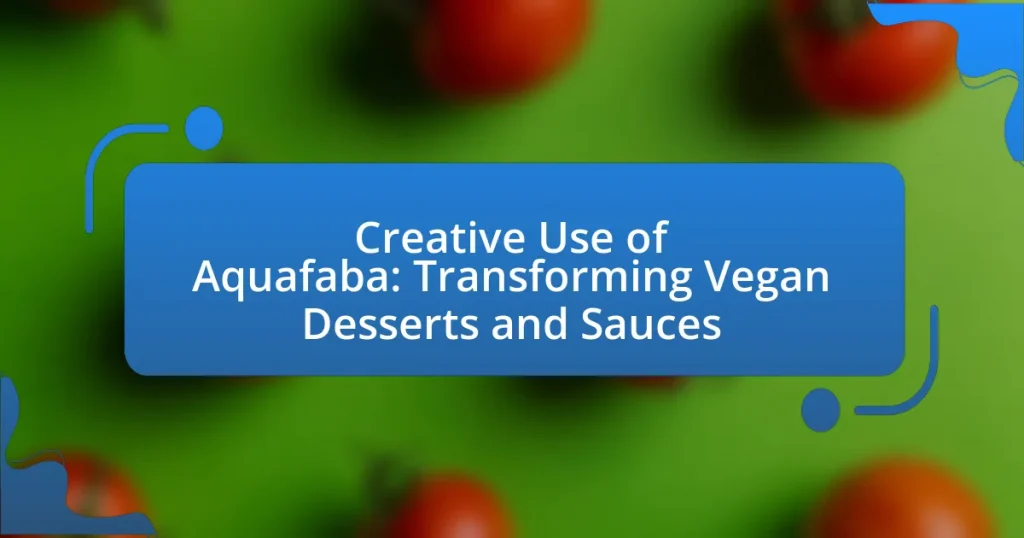Aquafaba, the viscous liquid derived from cooking legumes, primarily chickpeas, serves as a crucial egg white substitute in vegan cooking, mimicking properties such as foaming, binding, and emulsifying. This article explores the preparation and nutritional benefits of aquafaba, its comparison to traditional egg whites, and its creative applications in vegan desserts and sauces. Key techniques for enhancing its use, common mistakes to avoid, and practical tips for incorporating aquafaba into recipes are also discussed, highlighting its versatility and effectiveness in achieving desired textures and flavors in plant-based cooking.

What is Aquafaba and Why is it Important in Vegan Cooking?
Aquafaba is the viscous liquid derived from cooking legumes, primarily chickpeas, and it serves as an effective egg white substitute in vegan cooking. Its importance lies in its ability to mimic the properties of egg whites, such as foaming, binding, and emulsifying, which are crucial for creating textures in various dishes, particularly in desserts and sauces. Studies have shown that aquafaba can whip into stiff peaks, making it suitable for recipes like meringues and mousses, thereby allowing vegans to enjoy traditional recipes without animal products.
How is Aquafaba Made?
Aquafaba is made by cooking legumes, primarily chickpeas, in water and then straining the liquid. The cooking process extracts proteins, starches, and other soluble components from the legumes, resulting in a viscous liquid that mimics the properties of egg whites. This liquid can be used as an egg substitute in various recipes, particularly in vegan desserts and sauces, due to its ability to create emulsions and foams.
What are the sources of Aquafaba?
Aquafaba is primarily sourced from the liquid of cooked legumes, most notably chickpeas. This liquid, which is a byproduct of cooking or canning, contains proteins and starches that mimic the properties of egg whites, making it a popular ingredient in vegan cooking. The use of aquafaba has gained traction in culinary practices, particularly for creating emulsions, foams, and meringues in vegan desserts and sauces.
How does the preparation process affect its properties?
The preparation process significantly affects the properties of aquafaba, primarily influencing its emulsifying, foaming, and thickening abilities. When aquafaba is whipped, the mechanical action incorporates air, creating a stable foam that can mimic egg whites in recipes, which is crucial for achieving desired textures in vegan desserts. Additionally, the concentration of aquafaba, determined by the cooking time and method of chickpeas, alters its viscosity and protein content, further impacting its functional properties. For instance, a longer cooking time can lead to a thicker aquafaba, enhancing its ability to stabilize emulsions in sauces.
What Nutritional Benefits Does Aquafaba Provide?
Aquafaba provides several nutritional benefits, including being low in calories, fat-free, and a source of plant-based protein. Specifically, it contains approximately 1 gram of protein per tablespoon, making it a suitable alternative for those seeking to reduce animal protein intake. Additionally, aquafaba is rich in essential amino acids, which are crucial for various bodily functions. Its low glycemic index also makes it a favorable option for individuals managing blood sugar levels. These attributes make aquafaba a versatile ingredient in vegan cooking, particularly in desserts and sauces, where it can mimic the properties of egg whites.
How does Aquafaba compare to traditional egg whites?
Aquafaba serves as a viable substitute for traditional egg whites, particularly in vegan cooking and baking. It can mimic the foaming and binding properties of egg whites, allowing for similar textures in recipes like meringues and mousses. Studies have shown that aquafaba can whip to a similar volume as egg whites, achieving peaks that are comparable in stability, making it effective for creating light and airy desserts. Additionally, aquafaba is cholesterol-free and lower in calories, providing a healthier alternative while still delivering the desired culinary results.
What are the health benefits of using Aquafaba in recipes?
Aquafaba offers several health benefits when used in recipes, primarily as a low-calorie, plant-based egg substitute. It contains proteins, carbohydrates, and small amounts of vitamins and minerals, making it a nutritious alternative for those seeking to reduce cholesterol intake or follow a vegan diet. Additionally, aquafaba is naturally gluten-free, which benefits individuals with gluten sensitivities. Its ability to create emulsions and foams enhances the texture of dishes without adding significant calories, supporting weight management. Studies indicate that incorporating plant-based ingredients like aquafaba can improve overall dietary quality, contributing to better health outcomes.
What are the Creative Uses of Aquafaba in Vegan Desserts?
Aquafaba is creatively used in vegan desserts primarily as an egg white substitute, enabling the creation of meringues, mousses, and cakes. This versatile ingredient, derived from the liquid of cooked chickpeas, can be whipped to form stiff peaks, mimicking the texture and functionality of egg whites in traditional recipes. For instance, aquafaba meringues can be baked into light, airy cookies, while aquafaba-based mousses achieve a creamy consistency without dairy. Additionally, it serves as a binding agent in brownies and pancakes, enhancing moisture and texture. The effectiveness of aquafaba in these applications is supported by its ability to emulsify and stabilize mixtures, making it a valuable component in the realm of vegan baking.
How can Aquafaba be used to create meringues?
Aquafaba can be used to create meringues by whipping it to form stiff peaks, similar to egg whites. This plant-based alternative, derived from the liquid of cooked chickpeas, contains proteins and starches that mimic the properties of egg whites, allowing it to trap air and create a stable foam. Studies have shown that aquafaba can be whipped to a similar volume and texture as egg whites, making it an effective substitute in vegan meringue recipes.
What are some popular vegan cakes that utilize Aquafaba?
Some popular vegan cakes that utilize aquafaba include chocolate mousse cake, lemon meringue cake, and vanilla sponge cake. Chocolate mousse cake often incorporates aquafaba to create a light and airy texture, allowing for a rich chocolate flavor without eggs. Lemon meringue cake uses aquafaba to replace egg whites, achieving a fluffy meringue topping that complements the tart lemon filling. Vanilla sponge cake benefits from aquafaba’s emulsifying properties, resulting in a moist and tender crumb. These cakes demonstrate aquafaba’s versatility in vegan baking, providing structure and texture similar to traditional egg-based recipes.

How Can Aquafaba Transform Sauces and Dressings?
Aquafaba can transform sauces and dressings by acting as an emulsifier, stabilizer, and thickening agent. This plant-based liquid, derived from chickpeas, mimics the properties of egg whites, allowing for the creation of creamy textures without animal products. For instance, when blended into vinaigrettes or creamy dressings, aquafaba enhances the consistency and mouthfeel, making them richer and more satisfying. Additionally, its ability to hold air when whipped can create light and airy sauces, such as mousses or foams, which elevate the overall dining experience. Studies have shown that aquafaba can replace eggs in various recipes, providing similar functional benefits, thus proving its versatility in vegan cooking.
What Types of Sauces Can Be Made with Aquafaba?
Aquafaba can be used to create a variety of sauces, including mayonnaise, aioli, and salad dressings. These sauces leverage aquafaba’s emulsifying properties, allowing for a creamy texture without the use of eggs or dairy. For instance, aquafaba mayonnaise typically combines aquafaba with oil, vinegar, and mustard, resulting in a stable and rich condiment. Additionally, aquafaba can be whipped to create a light and airy texture, making it suitable for sauces like vegan hollandaise or meringue-based sauces.
How does Aquafaba enhance the texture of sauces?
Aquafaba enhances the texture of sauces by acting as an emulsifier and thickening agent. This plant-based liquid, derived from chickpeas, contains proteins and starches that help to stabilize and bind ingredients together, resulting in a creamy and smooth consistency. Studies have shown that aquafaba can mimic the properties of egg whites, allowing sauces to achieve a velvety texture without the use of animal products.
What are some examples of dressings that benefit from Aquafaba?
Examples of dressings that benefit from aquafaba include vegan mayonnaise, creamy salad dressings, and vinaigrettes. Vegan mayonnaise utilizes aquafaba as an emulsifier, creating a smooth texture similar to traditional mayonnaise. Creamy salad dressings, such as ranch or Caesar, can incorporate aquafaba to achieve a rich consistency without dairy. Vinaigrettes can also be enhanced with aquafaba to improve emulsification, resulting in a well-blended dressing that adheres better to salads.
How Does Aquafaba Affect Flavor Profiles in Sauces?
Aquafaba enhances flavor profiles in sauces by acting as a binding and emulsifying agent, which helps to create a smoother texture and more cohesive flavor. This property allows aquafaba to integrate well with various ingredients, improving the overall mouthfeel and richness of sauces. Studies have shown that aquafaba can mimic the emulsifying properties of egg whites, which traditionally contribute to the texture and flavor balance in sauces, thereby allowing for a more complex flavor experience without the use of animal products.
What role does Aquafaba play in balancing flavors?
Aquafaba serves as an effective flavor balancer in vegan desserts and sauces by mimicking the properties of egg whites, which traditionally contribute to texture and taste. Its ability to emulsify and stabilize mixtures allows for a harmonious blend of flavors, enhancing the overall taste profile. For instance, aquafaba can soften the intensity of bitter or acidic ingredients, creating a more rounded flavor experience. This is particularly evident in recipes where it is used to replace eggs, as it helps to integrate diverse components seamlessly, ensuring that no single flavor overpowers the others.
How can Aquafaba be used to create creamy sauces without dairy?
Aquafaba can be used to create creamy sauces without dairy by emulsifying it with fats and flavorings, resulting in a rich texture. This plant-based liquid, derived from cooking legumes like chickpeas, contains proteins and starches that mimic the properties of egg whites, allowing it to bind and thicken sauces effectively. For instance, when blended with ingredients such as olive oil, nutritional yeast, and spices, aquafaba can produce a creamy consistency similar to traditional dairy-based sauces. Studies have shown that aquafaba can replace eggs in various recipes, demonstrating its versatility and effectiveness in achieving desired textures in vegan cooking.

What Techniques Can Enhance the Use of Aquafaba in Cooking?
Techniques that can enhance the use of aquafaba in cooking include whipping, reducing, and flavoring. Whipping aquafaba creates a stable foam, making it ideal for meringues and mousses, as it can hold peaks similar to egg whites. Reducing aquafaba by simmering concentrates its flavor and thickens it, which is beneficial for sauces and dressings. Additionally, flavoring aquafaba with spices or extracts can enhance its versatility in various dishes, allowing it to complement both sweet and savory recipes. These techniques leverage the unique properties of aquafaba, making it a powerful ingredient in vegan cooking.
How Can You Whip Aquafaba to Achieve Desired Consistency?
To whip aquafaba to achieve the desired consistency, begin by using the liquid from canned chickpeas or the cooking water from dried chickpeas, ensuring it is at room temperature. Whipping aquafaba requires a mixer; use a stand mixer or hand mixer on high speed for approximately 5 to 10 minutes until soft peaks form, similar to egg whites. For a stiffer consistency, continue whipping until stiff peaks are achieved, which can take an additional 2 to 5 minutes. The effectiveness of aquafaba as a whipping agent is due to its protein content, which stabilizes the foam, allowing it to hold air and create volume, making it suitable for vegan meringues and mousses.
What tools are best for whipping Aquafaba?
The best tools for whipping aquafaba are electric mixers, hand whisks, and immersion blenders. Electric mixers, particularly stand mixers, can achieve the desired peaks and volume quickly due to their high speed and consistent mixing action. Hand whisks are effective for smaller quantities, allowing for manual control, though they require more effort and time. Immersion blenders can also whip aquafaba effectively, providing a convenient option for those who prefer a compact tool. Studies have shown that electric mixers can whip aquafaba to stiff peaks in about 5 to 10 minutes, making them the most efficient choice for achieving the best texture in vegan desserts and sauces.
What tips can help achieve stable peaks in whipped Aquafaba?
To achieve stable peaks in whipped Aquafaba, it is essential to use chilled Aquafaba, as cooler temperatures enhance its ability to whip. Additionally, incorporating an acid, such as cream of tartar or lemon juice, helps stabilize the foam by strengthening the protein structure. Whipping at a medium speed initially and gradually increasing to high speed allows for better incorporation of air, leading to firmer peaks. Finally, ensuring that all equipment is clean and free from grease is crucial, as any residue can hinder the whipping process. These methods are supported by the fact that Aquafaba, derived from chickpeas, contains proteins and starches that can mimic egg whites when whipped, making these techniques effective for achieving desired results.
What Common Mistakes Should Be Avoided When Using Aquafaba?
Common mistakes to avoid when using aquafaba include not properly whipping it, using the wrong type of aquafaba, and failing to account for its unique properties. Proper whipping is crucial; aquafaba should be whipped until stiff peaks form, similar to egg whites, to achieve the desired texture in recipes. Using aquafaba from canned chickpeas is generally recommended, as it has a consistent composition, while homemade versions may vary in quality and effectiveness. Additionally, aquafaba behaves differently than eggs in recipes, so adjustments in measurements and other ingredients may be necessary to ensure successful outcomes.
How can improper measurements affect the outcome?
Improper measurements can significantly alter the texture and flavor of vegan desserts and sauces made with aquafaba. For instance, using too much aquafaba can lead to a watery consistency, while insufficient amounts may result in a dense or unwhipped product. Accurate measurements are crucial because aquafaba’s effectiveness as an egg substitute relies on its specific properties, such as viscosity and aeration capacity. Studies have shown that precise ratios of aquafaba to other ingredients are essential for achieving the desired stability and mouthfeel in recipes, underscoring the importance of measurement in culinary outcomes.
What are the signs of over-whipped Aquafaba?
The signs of over-whipped Aquafaba include a grainy texture, loss of volume, and a tendency to separate or collapse. When Aquafaba is over-whipped, it can become too stiff, resulting in a dry and unmanageable consistency that does not hold its shape. This occurs because the proteins in Aquafaba have been excessively agitated, leading to the formation of large air bubbles that eventually destabilize.
What Are Some Practical Tips for Incorporating Aquafaba into Your Recipes?
To incorporate aquafaba into your recipes effectively, use it as a substitute for egg whites in meringues, mousses, and baked goods. Aquafaba, the liquid from canned chickpeas, can be whipped to form peaks similar to egg whites, making it ideal for vegan desserts. For best results, use three tablespoons of aquafaba to replace one egg white. Additionally, ensure that the aquafaba is at room temperature for optimal whipping. This method has been validated by various culinary experts who highlight its versatility in creating light and airy textures in vegan dishes.


